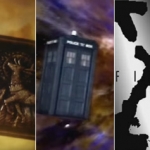It is something that has happened eleven times before, and this Christmas evening it will happen again: the Doctor will regenerate. His current body will die and a new one will take its place — new look, new personality, new everything except the name and the dual hearts. We don’t yet know what will cause the fall of the Eleventh and the rise of the Twelfth, but we can look back to see how it has gone down in the past.
First Doctor:
Actor: William Hartnell
Regenerated In: “The Tenth Planet” (1966)
Cause of Death: Old age
Much like the actor that played him, the first Doctor had basically just worn out his body. The production Powers That Be decided to replace William Hartnell after his failing health began to be an issue on set, so the idea of regeneration was born in 1966 to explain the sudden appearance of Patrick Troughton in the title role of the popular show. At the end of the 1966 story “The Tenth Planet”, which also saw the introduction of the Cybermen, his first body’s age finally catches up with him. Entering the TARDIS after the enemy is defeated, the Doctor declares that he is “wearing a bit thin” and collapses on the floor, taking on his second form.
Second Doctor:
Actor: Patrick Troughton
Regenerated In: “The War Games” (1969)
Cause of Death: None (Forced Regeneration)
The Second Doctor is commonly known as the “Cosmic Hobo,” traipsing around time and space and meeting up with such memorable monsters as the Cybermen, Daleks, the Yeti, the Ice Warriors, and the Great Intelligence. His companions included fan favorite Jamie McCrimmon and the very victorian Victoria Wakefield. The Time Lords catch up with him eventually, however, and accuse him of interfering in events despite being forbidden to do so. In the ensuing trial, the Doctor manages to convince them that his actions actually helped save many people. However, they still declare that he must be punished and sentence him to exile on 20th Century Earth and force him to regenerate. Interestingly, he is given a choice of appearance, although he rejects all of the choices given to him by the Time Lords.
Third Doctor:
Actor: Jon Pertwee
Regenerated In: “The Planet of the Spiders” (1974)
Cause of Death: Radiation from Metebelis crystals
The Third Doctor’s era was marked by his work as the scientific adviser to UNIT and his interaction with the legendary Brigadier Lethbridge-Stewart. By the end of it, however, he’s on the move again. In “The Planet of the Spiders”, he ultimately discovers that he must return a crystal he had taken from Metebelis III in a previous adventure in order to set the universe to rights again. He succeeds, but he receives a lethal dose of radiation in the process.
Fourth Doctor:
Actor: Tom Baker
Regenerated In: “Logopolis” (1981)
Cause of Death: Fall
Whether because of his long residence in the TARDIS or the fact that PBS in the United States showed his episodes in the 1980s, thus introducing legions of Americans to the phenomenon that is Doctor Who, the Fourth Doctor is probably the best known and most popular classic Doctor; indeed, he still ranks high even when compared to the Doctors of New Who. After a long run of adventures, the Doctor goes to Logopolis seeking help in repairing the TARDIS’s stuck Chameleon Circuit. Along the way, he has run-ins with the Master and the mysterious Watcher. While working with the deceitful Master in an attempt to prevent the collapse of the universe, the Doctor climbs onto the gantry of a radio telescope which the Master then tilts, causing the Doctor’s fatal fall.
Fifth Doctor:
Actor: Peter Davison
Regenerated In: “The Caves of Androzani” (1984)
Cause of Death: Spectrox toxaemia
Peter Davison was the youngest Doctor so far when he took over from Tom Baker in 1981. His trip around the universe in cricket whites came to an end three years later, however, on Androzani Minor, where he and companion Peri found themselves in the midst of a war. They both end up with spectrox toxaemia after touching unrefined spectrox, a valuable substance to the inhabitants of Androzani but a deadly neurotoxin in its natural state. The Doctor is able to obtain the bat milk anti-toxin, but he spills some of it, leaving only enough for one of them. He makes it back to the TARDIS just in time to give the antidote to Peri before succumbing himself. This regeneration marks the first of several times that the Doctor sacrifices his own life to save that of a companion.
Sixth Doctor:
Actor: Colin Baker
Regenerated In: “Time and the Rani” (1987)
Cause of Death: Crash landing (?)
Colin Baker was not actually around for the regeneration of the Sixth Doctor into the Seventh, due to his being asked to leave the year before. At the beginning of Sylvester McCoy’s first outing as the Doctor, he dons a blond wig for the opening scene of “Time and the Rani” — we see the familiar curly hair and outrageous jacket on the figure lying on the floor of the TARDIS after it crashes on a rocky planet. When the Rani and her henchmen enter the TARDIS and turn him over, all of a sudden the swirly regeneration light obscures his face briefly before dissolving into McCoy’s. I assume the hard landing made the Doctor hit his head on the console or something — his companion Mel is also lying unconscious on the floor when the Rani enters — but it appears that no explicit explanation for this death is ever given or shown.
Seventh Doctor:
Actor: Sylvester McCoy
Regenerated In: “Doctor Who” (1996)
Cause of Death: Gunshot wounds
The Seventh Doctor was still adventuring around the universe when classic series Doctor Who ended in 1989, so his regeneration did not occur until the TV movie seven years later. While transporting the Master’s ashes back to Gallifrey, it turns out that the Doctor’s old enemy is not quite as dead as everyone thought and still perfectly able to cause mischief. The TARDIS must make an emergency landing in San Francisco, right in the middle of a gang war, as the Doctor discovers when he steps out into a hail of bullets. He makes it to the hospital where medical doctors attempt to save him but he dies when they don’t know how to operate on his alien anatomy.
Eighth Doctor:
Actor: Paul McGann
Regenerated In: “The Night of the Doctor” (Mini-webisode released as a lead up to the 50th anniversary special in November, 2013)
Cause of Death: Crash Landing
When Doctor Who returned to television in 2005 with the Ninth Doctor, it was assumed that the Eighth had died as a result of the horrific ending of the Time War that haunted this new incarnation. We found out eight years later, in “The Name of the Doctor” (2013), that in fact there was another body between Eight and Nine who had done something so unspeakably terrible that he was no longer worthy to be called “doctor.” As a prequel teaser to the 50th Anniversary episode, Steven Moffat gave us a gift — Eight’s regeneration. We find him attempting to help the young pilot of a crashing spaceship, but she refuses his help and they both buy the farm. The Sisterhood of Karn resurrects Eight long enough for him to choose a cup, the contents of which will control his regeneration. He chooses the one specially prepared for him that will turn him from the Doctor into the warrior he needs to be in order to fight, and ultimately end, the Time War.
“War” Doctor:
Actor: John Hurt
Regenerated In: “The Day of the Doctor” (2013)
Cause of Death: Old Age
The War Doctor is introduced at the end of the series seven episode “The Name of the Doctor” and turns out to be a central figure in the 50th anniversary special, “The Day of the Doctor”. He has survived years of fighting in the Time War, but after an adventure with his two most manic future selves, can you blame him for feeling like he is once again “wearing a bit thin?”
Ninth Doctor:
Actor: Christopher Eccleston
Regenerated In: “The Parting of the Ways” (2005)
Cause of Death: Absorption of vortex energy
After getting to travel with Rose Tyler, having adventures and saving the universe, the Doctor finally meets his match when he comes up against the Daleks on Satellite Five in Earth’s distant future. Rose saves the day when she becomes the Bad Wolf after looking into the heart of the TARDIS and taking in vortex energy. This same energy that saves the world is quickly killing her frail human body, however, so with a kiss the Doctor draws it out of her, compromising himself in the process. For the second time, he gives up his own life to save his companion’s, and a new Doctor (with fabulous hair) is born.
Tenth Doctor:
Actor: David Tennant
Regenerated In: “The End of Time” (2009-10)
Cause of Death: Radiation
Ten had some good times with Rose, Martha, and Donna, but all good things must come to an end. He has an epic battle with the Master for control of Earth and all of its people and succeeds in saving the universe, as usual. He survives everything the Master throws at him, a wild ride down stairs while strapped to a wheel chair, a fall from a space ship through a glass skylight — and he’s still going strong. Until he hears the prophesied four knocks, that is. Wilfred Mott is stuck inside the alien device’s nuclear-powered control booth that is about to spectacularly fail, and he can only get out if someone enters the other side and releases his door. The Doctor does this, absorbing a fatal dose of radiation from the booth’s power source. Death is not immediate, however — he has time for a farewell tour of past companions before Eleven bursts on the scene.
(Side note: Steven Moffat is now saying that Ten’s aborted regeneration in “The Stolen Earth” counts as an actual regeneration, but since it was not a full regeneration and no change of appearance took place, I’m not going to go into it here.)
Eleventh Doctor:
Actor: Matt Smith
Regenerating in: “The Time of The Doctor” (December 25, 2013)
Cause of Death: ????
So what will happen to Eleven? All we know is that at the end of this year’s Christmas special Matt Smith will bow out and regeneration will occur once more, leaving us to meet the next Doctor, Peter Capaldi. I can’t wait — what about you?
The author would like to acknowledge the TARDIS Data Core Doctor Who Wiki as the source of much of the information about the Doctors’ regenerations, particularly the Classic Doctors. If I have not provided enough detail to suit you, head on over there!








For a look at past regenerations from a different perspective, check out Alasdair Wilkins’s interesting article over on io9: http://io9.com/what-every-doctor-who-regeneration-says-about-each-doct-1489242422